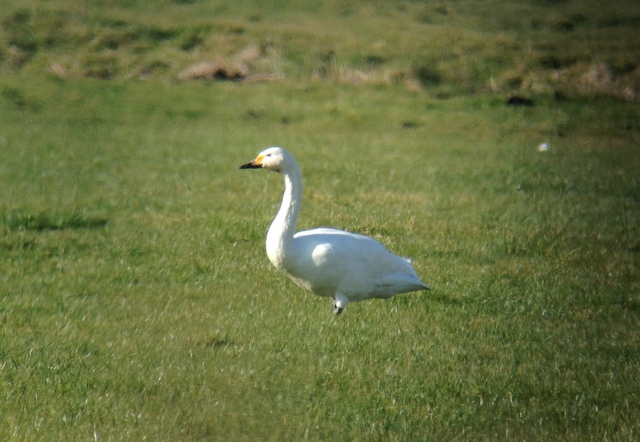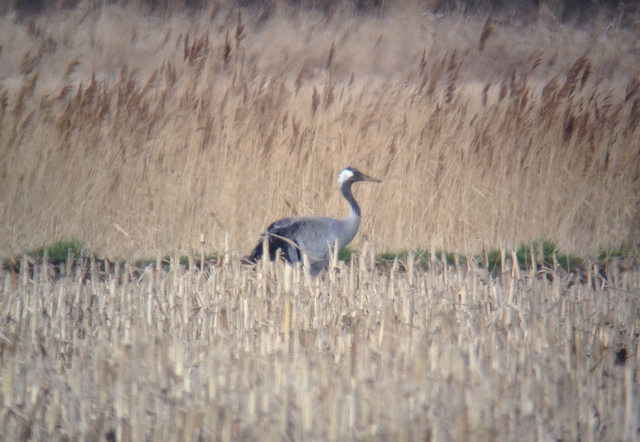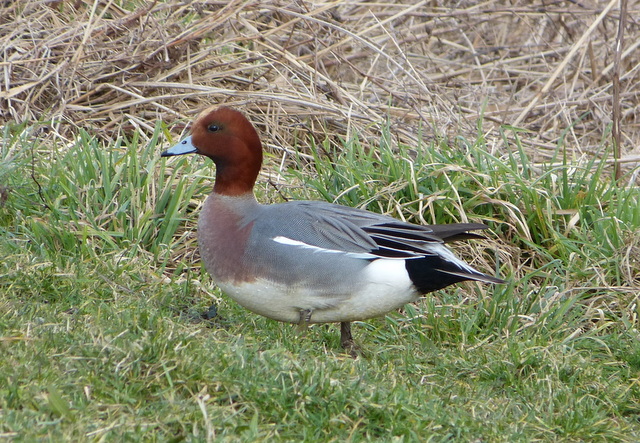Day 2 of a long weekend of tours today. We headed down to the Broads for the day, to look for some of the local specialities.
We started off on a search for the Cranes. It didn’t take us long. There was no sign of any around the first of the favoured fields we visited, but a short drive further and a glance out of the side window revealed two large birds flying past in the opposite direction – unmistakeable with long necks held outstretched in front and long legs trailing behind – two Common (or Eurasian) Cranes. We turned round and followed them and they dropped towards the area we had just been searching. As most of us were watching the two, one member of the party announced “there’s four”. A quick scan showed he was right – but there were actually six. We watched them all dropping down to the fields, but unfortunately they landed out of view. Still, a great start with six Cranes already.
 Cranes – these two flew past the car first thing this morning
Cranes – these two flew past the car first thing this morning
Round at Horsey, we stopped to admire a couple of short-cropped grass fields which were positively chock full of birds. There were lots of Golden Plover, Lapwings, Fieldfares and Starlings. A couple of Common Buzzards sat around on the neighbouring bushes and fenceposts in the morning sun, occasionally flapping across the field lazily. The throng seemed to ignore them completely. Then suddenly, the whole lot took to the air, separating instantly into species flocks – the Golden Plover whirling high in the air in an amorphous group, changing shape all the time; the Lapwings flapping off more sedately below; and the Fieldfares flying away strongly calling as they went, leaving a few bemused birds in the field left wondering what the commotion was all about. Then we spotted the culprit, as a Sparrowhawk swept low over the road and away across the fields the other side.
 Golden Plover – part of the flock that took fright and whirled round
Golden Plover – part of the flock that took fright and whirled round
Most of the Pink-footed Geese appear to have departed north already, but there were still a hundred or so out on the grass. Scanning through the flock, a couple of heads appeared from a dip in the ground behind and their white foreheads caught the sun. A small group of White-fronted Geese still lingering and taking advantage of the company of the Pinkfeet.
While we were admiring the array of birds spread out in front of us, another Crane appeared in the sky at the back of the field. As it flew past us, we could see that one of its legs was dangling below, not held out straight as it should be. We had seen this injured bird near here back in mid-January (and it had apparently been present in the area for a couple of weeks before that). Then, it appeared to be struggling on the ground, but today it landed in the distance and appeared to be a little more steady on its feet. Sad to see it still suffering, but good that it appears to be surviving and possibly even adapting to its injury.
From there, we headed inland towards Ludham. The wild swans used to winter in the fields on the coast, but these days they favour a different area. We drove straight out onto the levels and had not gone far when we spotted a line of swans – mostly Bewick’s Swans with several Mute Swans as well. A quick scan revealed four birds with the Bewick’s which were larger, with more yellow on the bill. Looking through the scope confirmed they were four Whooper Swans – nice to see them still here, and to be able to compare the two species side by side. A little further on, a small, low-slung shape ran across the road – a Weasel. We pulled up alongside it and watched it darting around in the grass right beside the car, before it realised we were there and shot off into the trees.
 Bewick’s Swans – around 44 still on St Benet’s levels today
Bewick’s Swans – around 44 still on St Benet’s levels today
 Whooper Swans – just 4 still lurking in amongst the Bewick’s
Whooper Swans – just 4 still lurking in amongst the Bewick’s
Next stop was over in the Yare valley, but the journey there takes us through more Crane country. Out of the corner of an eye, as we were driving past, an odd shape amongst the clods of ploughed earth and maize stubble caught the attention. A quick turn into a conveniently positioned gateway and we were able to scan the field. Surely it had just been another large lump of ploughed soil? No, our initial suspicions were confirmed, it was the tail of another Crane feeding head down! We positioned ourselves carefully amongst some farm buildings and had a great views of it in the scope, especially once it finally lifted its head up. It seemed fairly unconcerned by our presence, and we left it feeding by itself.
 Crane – the bushy black tail caught our attention as we drove past…
Crane – the bushy black tail caught our attention as we drove past…
 Crane – … but we got much better views when it lifted its head
Crane – … but we got much better views when it lifted its head
Down at Buckenham Marshes, we walked out to the riverbank. There were lots of ducks – mostly Wigeon, some of them proving very tame and performing for the cameras, but amongst them a smattering of Shoveler, Teal and Gadwall. A small group of Tufted Ducks was swimming in one of the flooded channels. Several Shelduck were out on the grazing marshes, but the only geese we could find today were Canada and Greylag Geese.
 Wigeon – performed for the cameras
Wigeon – performed for the cameras
There are usually large flocks of Golden Plover and Lapwing out on the grass, but today when they spooked they seemed to do so with added urgency, swirling round in a frenzy. Everything took off at once – waders, ducks, geese. Looking through the swirling flocks, we could see why – an adult Peregrine was scything through, repeatedly turning and going back through the middle of the horde. Suddenly it slammed into something, possibly a Teal, but it couldn’t hold onto it and the victim appeared to drop like a stone straight into one of the flooded ditches. The Peregrine circled overhead, but seemed resigned to having lost its prey and dropped down onto a gatepost nearby to reflect on its misfortune.
 Peregrine – hunting at Buckenham Marshes
Peregrine – hunting at Buckenham Marshes
While the Peregrine was busy putting everything up, we could see there were more waders over on some flooded flashes out on the grass by the old windpump. We walked along the bank and through our scopes we could see a nice group of Ruff, including a couple of very white-headed males, plus a good flock of Dunlin running around amongst the Starlings and, over at the back, twenty or so Black-tailed Godwits.
We stopped at Strumpshaw Fen for lunch. The car park was very full again, but that didn’t put off the Marsh Tits and Long-tailed Tits around the bushes. A quick visit to Reception Hide confirmed that the reserve was very quiet again bird-wise, and with staff worries about flooding along the river on the rapidly approaching high tide, we decided to move on.
Down at Halvergate, the Rough-legged Buzzard was rather annoyingly not on its usual line of fenceposts – it had taken off and was hovering further out over the grazing marshes. It landed on a gatepost in the distance, and stood there for some time, showing no inclination to move. So we decided to leave it for a short while and explore further out across the levels. Just down the road, a stop to scan the marshes produced another flock of 43 Bewick’s Swans, a single Chinese Water Deer and a noisy flock of Fieldfares which wanted to land back in the hawthorns beside us but wouldn’t settle while we were standing there.
 Bewick’s Swans – a tight group of 43 was still at Halvergate today
Bewick’s Swans – a tight group of 43 was still at Halvergate today
Further out on the levels, we stopped and went for a walk. As soon as we got out of the car, a Barn Owl ghosted towards us, spotting us at the last minute and wheeled away over the fields. A ringtail Hen Harrier appeared over a bank, but turned and dropped down just out of view. We had just positioned ourselves to be able to see it through the reeds, standing on the ground, when it took off again and continued quartering out across the marshes. But it was a great view as it went, and it appeared to be a young bird with yellow-tinged streaked underparts and dark under-secondaries. Then the Short-eared Owls started to appear, first one, then a second, then a third, all out hunting over the fields, though unfortunately all rather distant. Still, it is a magical place and we eventually had to tear ourselves away.
Back where we had been earlier, the Rough-legged Buzzard had finally decided to return to its usual fenceposts so we stopped again for another look. We had a much better view of it now, noting it’s dark-streaked but very pale head and its strikingly blackish belly patch as it stood facing us. It took off and flew a couple of times, just a short distance between posts, flashing its bright white tail base as it turned to land each time. There was another Barn Owl out hunting here now, but no sign yet of the hoped for closer Short-eared. We were already running out of time to get back to the roost at Stubb Mill, so unfortunately we had to drag ourselves away again.
 Rough-legged Buzzard – back on one of its usual fenceposts
Rough-legged Buzzard – back on one of its usual fenceposts
We arrived at Stubb Mill a bit later than planned, after our distraction at Halvergate. It had looked like we might get away with our slightly tardy arrival, but the beautiful winter sunshine we had enjoyed most of the day just failed us at the last, as a patch of dark cloud on the horizon moved in front of the setting sun. The watchpoint was unbelievably busy today, and we were lucky that a few people had started to drift off for an early bath which left a space for us to stand.
 Stubb Mill – the approach to the watchpoint
Stubb Mill – the approach to the watchpoint
Several Marsh Harriers were already in, perched up in the bushes or circling over the reeds. As we scanned the marshes ahead of us, we could see more birds drifting in, in ones and twos. There were probably close to thirty at the roost again tonight. Another Barn Owl was out hunting over the grass in front of us. A Stonechat on the bushes was a new bird for the day’s list. Then a ringtail Hen Harrier appeared, coming in fast and low at the back of the grazing marsh ahead of us. The male was less accommodating today, and we just glimpsed him briefly tonight flying round amongst the bushes in the distance – he had clearly sneaked into the roost via a different route! A small falcon perched up in the bushes was most likely a Merlin, but it was getting hard to see clearly by that stage.
As the light faded we could hear Cranes constantly bugling away to the north, much more noisy than they have been in recent weeks. Each time, it seemed like they had to be on their way, but the big group didn’t appear before it was getting a bit too gloomy. Two birds did come over – coming from the other direction, they were probably the pair which regularly feeds out from the watchpoint, and they gave us a good flypast before they dropped down into the reeds across the marshes. It seemed like a good way to bookend the day – a mirror of the start, watching two Cranes flying past. We headed back to the car, with a glorious sunset fading in the sky.

















